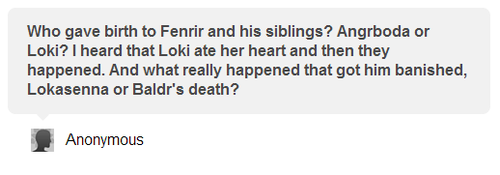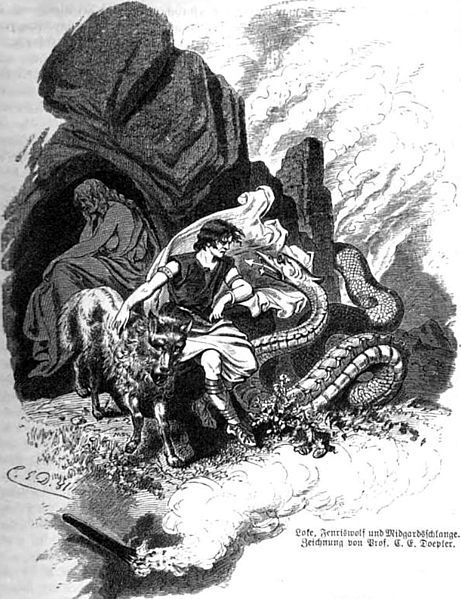#gullveig

The birth-mother of Fenrir, Hel, and Jormungandr is, for the most part, said to be Angrboda, with Loki as the father. I disagree with this claim, and believe Loki to be the birth-mother. There is support for both the former and latter, but that point is not made clear enough in our surviving sources to make a proper conclusion.
The idea of Angrboda as mother of the brood has merit in its simplicity. Most people assume the female to be the mother, and the male to be the father. Angrboda is female, Loki is male. The mother/father is not explicitly stated, so perhaps the simplest explanation should be assumed.
This claim also tends to go hand-in-hand with the assertion that Angrboda is Loki’s mistress or other wife in Jotunheimr, but this seems completely unfounded to me. There is really no evidence of a relationship having ever existed between the two, or that they even knew one another. I suppose Loki’s self-professed promiscuity could explain him fathering children with a completely arbitrary woman, but casting Angrboda as Loki’s wife seems to be too lazy an assumption.
The incident on which Loki eats a woman’s heart comes from Hyndluljod, a source more dated than Snorri, in the Poetic Edda; as such, I feel the references therein are more accurate to authentic Norse mythology. The account is incredibly vague, and all that is revealed is that Loki eats the half-cooked heart of an “evil woman” that he takes from the embers. He becomes pregnant from this, and gives birth to “the monsters” (flagð). It is not made clear to which “evil woman” the heart belongs, or to what beings “the monsters” refers.
“The monsters” may refer to Fenrir, Jormungandr, and Hel – they are indeed the most suited for the title, among Loki’s other offspring.

These three “monsters” are usually attributed to the union of Angrboda and Loki, so if it is assumed these three are “the monsters”, then it must also be assumed that the heart belonged to Angrboda. One section of Hyndluljod states that Loki gained the wolf (Fenrir) by Angrboda, which may imply that it was Loki impregnated by Angrboda.
The heart that Loki ate is a mystery all on its own, and its origins should be considered before attributing it to Angrboda. It came from an “evil woman”, Loki took it from the embers, and it was half-cooked. The Voluspa, another entry in the Poetic Edda, mentions the Aesir-Vanir war, which came about when an “evil woman” named Gullveig was thrust with spears and burned by the Aesir in Odin’s hall. We are told she was burnt and reborn three times over, and even that was not enough to destroy her. Perhaps a half-cooked heart remained, and this was the one Loki ate? Angrboda’s heart was said to be frozen like the sea spray, so this may be why the heart did not burn when the rest of the body did. Loki’s reason for eating the heart may have been to prevent further resurrection, which is very similar to Loki’s countless outlandish solutions to unsolvable problems facing the Aesir.
There is a great deal of evidence, although still not fully accepted, that Gullveig and Angrboda are one and the same. I’ll go into Angrboda/Gullveig/Heid in detail in a later post – I need to answer your question first and foremost, and if I start talking about Angrboda, I’ll never get around to it. Angrboda is written as Aurboda in Svipdagsmal, which gives the name the exact same meaning as Gullveig. “Aur” and “Gull” both mean gold, and “boda” and “veig” both refer to a strong alcoholic drink. From the above, although there is no concrete proof, there is a clear possibility that Loki was impregnated by eating Angrboda’s heart, and thus gave birth to his famous monstrous brood.
It is simplest to assume the female Angrboda as the mother, and the male Loki as the father, but we also have evidence to the contrary. There is a bit of confusion on this point, and it seems to be intentional. Angrboda is sometimes called the father, and Loki the mother, and then vice versa. Perhaps this is intended to call attention to the fact that the parentage is different from what is expected. Loki’s androgyny is definitely a theme in many of his myths, and Angrboda’s androgyny is also mentioned at one point (An observer cannot decide if Angrboda is a woman, or a man disguised as a woman). This may be further evidence of their mismatched parental roles.
Furthermore, in Helgakvida Hundingsbane I of the Poetic Edda, two characters are insulting one another by comparing one to Loki, and the other to Angrboda. The character comparing himself to Loki says to his Angrboda-like opponent that they produced the wolf together, and that he was the father. The Angrboda companion corrects him, saying that Loki is not the true father, and that he was emasculated by giving birth to the wolf. If Loki became pregnant by eating Angrboda’s heart, then it was Angrboda’s seed that fertilised Loki, making Angrboda the true father.
So there you go. We don’t know for sure whether the father is Loki or Angrboda, but I believe it was Angrboda, and there is indeed a good deal of support for this idea. There is some more evidence, but it requires a lot more explanation, so I might go into it again once I’ve properly explained Angrboda on this blog.
As for Loki’s banishment/getting bound, it was caused by the events of Lokasenna. For the most part, it seems that the gods bound Loki because they were really angry that he had slandered all of them. Granted, some of the slander was pretty bad, but a lot of it, if not all, was true. Loki knew everybody’s dirty little secrets, and when he revealed them all at the Lokasenna, he got into some trouble. I will write a post on Baldr’s death, and another on Lokasenna as soon as I can – sorry it’s taking so long! I’m pretty busy with university right now, and my major is Chemistry, which is about as far from Norse mythology as you can get…
Gullveig of the Nordic Ascendant
————————————————
1 Level 5 or lower “Nordic” monster
If this card is Link Summoned: You can banish up to 3 cards from your hand and/or field, and if you do, Special Summon that many “Nordic” monsters from your Deck in Defense Position, also, for the rest of this turn, you cannot Special Summon monsters, except “Aesir” monsters, nor Normal Summon/Set any monsters. You can only use this effect of “Gullveig of the Nordic Ascendant” once per turn. While this card points to an “Aesir” monster, your opponent cannot target that monster with card effects, also monsters your opponent controls cannot target this card for attacks.
————————————————
Can Be Found In: Legendary Hero Decks (LEHD-ENB00)
The Nordic archetype branches into three groups to assist on the arrival of the Aesir monsters. Three Nordic deities with powerful abilities to rule the game on their own, the build mainly consists of materials for their Synchro Summon as well some tools to make them even tougher to defeat. While usually a Deck arround these cards will focus on the arrival of a particular Aesir, Nordics gradually provided additional tools allowing them to summon any of its three leading Synchro Monsters when the situation requires their pressence.
“Gullveig of the Nordic Ascendant” is the Link Monster addition many archetypes are obtaining in recent years, offering an assortment of effects to immediately Synchro Summon as soon is out on the field. AS oon “Gullveig” is Link Summoned, we can banish up to three cards in our hand or field to then summon that number of Nordic monsters from the Deck in Defense Position. This will restrict us from any further summons for the rest of the Duel, with the exception of summoning Aesir monsters by Special Summon. But “Gullveig” can remain present on the field as long its arrow points an Aesir, not only becoming untargettable from attacks but also making itself and the Aesir protected from targetting effects. Overall “Gullveig” might seem a very expensive monster despite being a Rating 1 summon, but the trade off of banishing cards to swarm the board with materials and follow with a protected “Aesir” makes this Link Monster a strong option to start Duels with.
“Gullveig” compensates the cost of its summoning effect with a very cheap Link Summon, easily accesible by the majority of Nordic monsters residing the Main Deck. Some monsters like “Dverg of the Nordic Alfar” and “Mimir of the Nordic Ascendant” provides summoning effects before and after being the main material of “Gullveig”, making us not as dependant of its effect to gather materials during a Duel. Due the Type diversity of the archetype we can mix together options from outside the theme to further assure a material for this Link Summon, like “Rescue Rabbit” bringing copies of “Tanngrisnir of the Nordic Beasts” among other candidates. Truly the only issue “Gullveig” has is its scarce options if revived given its effects and arrow position, but might be helpful nonetheless to Link Summon other creatures if needed.
With an ability to trade cards on hand and field to bring Nordic monsters from inside our Deck, the arrival of “Gullveig” will surely follow with the Synchro Summon of an Aesir. While in most cases we will need minimum three monsters (Including a Tuner) to bring out any Aesir there’s no need to pay the full cost of “Gullveig”, as some Nordic cards will provide other effects of their own before or after this monster’s effect. “Alviss of the Nordic Alfar” can be banished by “Gullveig” effect to be the one performing the Synchro Summon using materials from the Deck, as otherwise can remain in the Graveyard to replace a defeated Aesier with another. Keep on mind that “Gullveig” as well the Aesir don’t need Nordic cards alone for their performance, so we can use cards like “Scapegoat” and “Photon Sanctuary” to either gather materials for the Synchro Summon (The latter only able to assist us with “Odin, Father of the Aesir”) or considerably mitigate the cost of “Gullveig” effect. But no matter the approach we take arround “Gullveig” it will lead to not only a powerful Synchro Monster in our field right on our first turn, but also its protective effect avoiding common threats from defeating this monster and the Aesir is pointing to.
Despite its very cheap Link Summon, “Gullveig” might seem a riskful monster given its summoning effect might leave us handless right from the start of a Duel. However, not only the Aesir are menacing monsters on their own along the protection provided by “Gullveig”, but there’s a variety of workarrounds to not solely depend on this monster’s abilities. With Token effects cheapening its cost as well cards like “Alviss of the Nordic Alfar” and “Rescue Cat” providing their own summoning abilities, “Gullveig” true problem is that must be in the Extra Monster Zone for its maximum performance. Overall, “Gullveig” might seem a heavy investment but assures a very strong board pressence along the Aesir we will summon as soon the Duel begins.
Personal Rating: A
+ When Link Summoned allows us to banish up to three cards to summon Nordics from the Deck
+ If points an Aesir both become untargetable by effects as well making itself avoid being attacked
+ Several options to cheapen its effect and/or work along
- Its summoning effect can leave us without cards right from the first turn
-Limited uses outside the Extra Monster Zone
Post link

